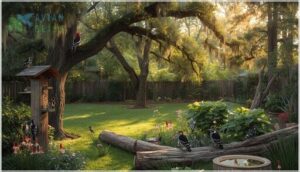This site is supported by our readers. We may earn a commission, at no cost to you, if you purchase through links.
If you’ve ever watched a woodpecker hammering away at a tree, you know it’s not just about the noise. Mississippi’s forests and backyards host a cast of woodpeckers that turn deadwood into real estate, tap out territorial signals, and flash bold patterns against the green.
From the tiny Downy with its delicate pecking to the Pileated’s thunderous drumming, these birds shape the landscape as much as they respond to it.
Whether you’re hoping to spot a rare Red-cockaded or just want to welcome more woodpeckers of Mississippi to your yard, knowing their habits brings the woods a bit closer to home.
Table Of Contents
- Key Takeaways
- Common Woodpecker Species in Mississippi
- Rare and Endangered Woodpeckers
- Identifying Mississippi Woodpeckers
- Habitats and Best Birdwatching Locations
- Attracting Woodpeckers to Your Yard
- Frequently Asked Questions (FAQs)
- What is the largest woodpecker in Mississippi?
- Are there red-headed woodpeckers in Mississippi?
- What is the difference between a ladderback woodpecker and a red-bellied woodpecker?
- Do male and female woodpeckers look the same?
- How can I deter woodpeckers from pecking my house?
- What is the best way to attract woodpeckers to my yard?
- Are woodpeckers protected by law in Mississippi?
- How do I identify different woodpecker species in my area?
- What should I do if I find a baby woodpecker on the ground?
- How do woodpeckers impact local insect populations?
- Conclusion
Key Takeaways
- Mississippi is home to several woodpecker species, from the tiny Downy to the large Pileated, each with unique behaviors and habitat needs.
- Conservation efforts focus on protecting rare species like the endangered Red-cockaded Woodpecker and the possibly extinct Ivory-billed Woodpecker.
- You can attract woodpeckers to your yard by providing suet feeders, leaving dead trees for nesting, and planting native vegetation.
- Woodpeckers play a key role in controlling insect populations and shaping forest habitats by creating nesting cavities and foraging for insects.
Common Woodpecker Species in Mississippi
Mississippi’s woods and fields are home to several woodpecker species you can spot year-round. Each has its own look, call, and habits worth noticing.
Here are the most common woodpeckers you’ll find across the state.
Downy Woodpecker
Spotting a Downy Woodpecker in Mississippi is like finding a tiny acrobat among the trees. You’ll notice their sparrow-sized frame and black-and-white patterning, especially if you’re scanning forest edges or city yards. Their adaptable feeding habits and clever nesting behavior keep populations healthy statewide. As the smallest woodpecker in North America, the Downy Woodpecker is a common sight.
- Size and Features
- Habitat Diversity
- Feeding Habits
- Nesting Behavior
- Population Status
Hairy Woodpecker
If you’ve noticed a larger black-and-white woodpecker with a chisel-like bill, you’re likely looking at a Hairy Woodpecker. These birds thrive in Mississippi’s mature forests, orchards, and even city parks.
Their strong beaks and loud drilling play a key role in forest ecology and Bird Conservation. Understanding Woodpecker Behavior helps with Identifying woodpecker species and supporting Wildlife Management.
They consume large numbers of wood-boring insects.
Northern Flicker
If you’re scanning Mississippi’s open woods or yards, the Northern Flicker stands out. Its spotted belly and black bib make Woodpecker identification easier. You’ll often see these birds foraging for ants—the Flicker Diet is unique among woodpeckers.
Keep an eye out for:
- Ground feeding
- Nest Competition with starlings
- Urban Hazards
- Ongoing Population Decline tracked by Citizen Science
Red-bellied Woodpecker
The RedBellied Woodpecker is one of Mississippi’s most adaptable birds. Thanks to strong population growth and impressive habitat flexibility, you’ll spot them in everything from deep woods to backyard parks. Their dietary adaptations mean they can thrive on insects or suburban snacks. Nesting competition with starlings poses a challenge, but overall, their conservation outlook in Mississippi remains bright.
| Key Trait | Detail |
|---|---|
| Plumage | Red crown, barred back |
| Diet | Insects, nuts, fruit, seeds |
| Nesting Sites | Dead trees, limbs |
| Urban Presence | High |
| Conservation Outlook | Stable, increasing |
Red-headed Woodpecker
The Red-headed Woodpecker is a Mississippi classic—think of it as a splash of color on an old barn.
Four facts to know:
- Population decline is real, due to habitat loss and nesting competition.
- Conservation efforts target open woodlands and dead trees.
- Seasonal migrations shape local sightings.
- Identifying this species? Watch for that unmistakable red crown and bold white body.
Pileated Woodpecker
A glimpse of a Pileated Woodpecker in Mississippi feels like spotting a forest heavyweight. With a wingspan of 28 inches, it dominates mature forest habitats.
Its Dietary Habits revolve around carpenter ants and berries, while unique Nesting Behavior shapes the canopy.
Watch for population trends—these woodpeckers thrive thanks to smart conservation, but changes in Forest Ecology bring real Conservation Challenges.
Yellow-bellied Sapsucker
Out in Mississippi’s hardwood stands, you’re likely to spot the Yellow-bellied Sapsucker—a master of sap well ecology. These woodpeckers drill neat rows of holes, not just for sap but for a winter diet that includes fruit and arthropods.
Their Sapsucker migration routes shape seasonal appearances, and they thrive in habitats blending mature trees—though urban edges bring new conservation challenges.
Rare and Endangered Woodpeckers
Some woodpecker species in Mississippi are much harder to spot than others. These rare birds face unique challenges and need special care to survive.
Here are two you should know about.
Red-cockaded Woodpecker
Ever wondered why some woodpeckers need old pine forests? The Red-cockaded Woodpecker relies on Longleaf Pine forests and cooperative breeding to survive. Endangered status means every bird counts.
Conservation efforts focus on habitat restoration and Pine Management. Population monitoring helps track these endangered woodpecker species. Without ongoing support, Red-cockaded Woodpeckers could vanish from Mississippi’s forests for good.
Ivory-billed Woodpecker
Could you imagine searching for a bird that mightn’t exist? The Ivory-billed Woodpecker sits at the heart of the Extinction Debate, with rare woodpecker sightings fueling Conservation Hopes. Habitat loss nearly erased it, but Future Research and ongoing conservation efforts keep the story alive.
The Ivory-billed Woodpecker, possibly extinct, remains a symbol of hope and mystery as conservationists search for signs of its survival
- Sighting Evidence remains debated
- Habitat loss threatens old-growth forests
- Conservation hopes inspire new searches
Identifying Mississippi Woodpeckers
Spotting a woodpecker in Mississippi can be easier when you know what to look and listen for. There are a few key traits that help you tell one species from another.
Here’s what matters most when you’re out in the field.
Physical Characteristics
Did you know the smallest woodpecker in Mississippi is just 5.5 inches long? When you’re spotting woodpecker species in Mississippi, pay close attention to plumage patterns, bill morphology, and sexual dimorphism. Size variation is obvious—from tiny Downy to giant Pileated.
Physical adaptations like stiff tail feathers and zygodactyl feet help these birds cling and peck with precision.
Calls and Drumming Patterns
Sound is your secret tool for identifying woodpeckers by species. Listen for woodpecker calls and sounds—like the Northern Flicker’s laugh or the Pileated’s deep “cuk-cuk-cuk.” Drumming communication changes with context and habitat.
Check out these clues:
- Species variations in calls
- Drumming sounds for territory
- Temporal patterns (morning peaks)
- Call functions (alarm, mate)
- Environmental impact on resonance
Seasonal Plumage Changes
Just as calls help with woodpecker identification, bird plumage tells its own story. Watch for color variation and feather wear, especially after the molting cycle. Juvenile plumage changes quickly—Downy Woodpeckers mimic Hairy patterns, and Northern Flickers shift colors with diet.
Here’s a quick look at seasonal plumage changes:
| Species | Molting Cycle |
|---|---|
| Downy Woodpecker | Summer-Autumn |
| Northern Flicker | Late Summer |
Habitats and Best Birdwatching Locations
If you want to spot woodpeckers in Mississippi, knowing where to look makes all the difference. These birds favor certain habitats and tend to follow seasonal patterns.
Here are some of the best places and times to find them.
National Forests and Wildlife Refuges
Within Mississippi’s National Forests and Wildlife Refuges, you’ll find diverse forest habitats supporting woodpecker populations. Conservation efforts and careful refuge management help protect mature pine stands, which are key for species like the endangered Red-cockaded Woodpecker.
For birdwatching, early mornings in Bienville or Noxubee Refuge offer the best chance to observe population trends and woodpecker behavior up close.
Urban and Suburban Areas
Just beyond the forests, Mississippi’s urban and suburban areas offer a front-row seat to woodpecker adaptation. Backyard birds like the Red-bellied and Downy Woodpeckers thrive at bird feeders, showing clear feeder dominance.
Urban nesting relies on deadwood importance—preserved old trees mean more nests. Species adaptation is clear, but conservation challenges remain if deadwood disappears from neighborhoods.
Migratory Patterns and Seasonal Movements
When fall rolls in, Mississippi becomes a crossroads for migratory birds. Woodpecker migration patterns shift with climate impacts and food changes—acorns, sap, and insects are migration triggers.
Yellow-bellied Sapsuckers fill winter habitats, while Red-headed Woodpeckers use flyway corridors and stopover sites.
Your best sightings? Watch forest edges and river bottoms when migration peaks.
Attracting Woodpeckers to Your Yard
If you want woodpeckers to visit your yard, a few simple changes can make a big difference. It’s all about giving them the right food, shelter, and space.
Here’s what you can do to make your yard more inviting.
Food Sources and Feeders
Ever wonder why woodpeckers tap your suet feeder all winter? Their natural diets shift with the seasons—ants and larvae in summer, nuts and suet in winter.
Using backyard feeders packed with suet, sunflower seeds, or peanuts aids woodpecker feeding habits and can boost local populations.
Foraging behavior adapts, so offering varied feeder types keeps attracting woodpeckers to your yard year-round.
Nesting Sites and Cavity Creation
If you want woodpeckers nesting nearby, leave dead limbs or pine trees standing. These offer prime Nesting Trees for the Excavation Process.
Woodpecker nesting habits rely on trees with soft wood, where they create round or downward-facing Nesting cavities. Cavity Reuse is common, but some species prefer fresh Tree cavities.
Hole Orientation and Habitat Influence matter—variety helps attract more birds.
Creating a Woodpecker-Friendly Habitat
Did you know a single dead tree can transform your yard into a woodpecker haven? Snag Management is essential—leave snags standing for nesting and feeding.
Plant Native Vegetation like oaks and pines to boost insect diversity. Food Provision with suet and seeds, plus clean Water Sources, promotes woodpecker habitat preferences.
Smart Forest Management benefits Backyard birding across Mississippi.
Frequently Asked Questions (FAQs)
What is the largest woodpecker in Mississippi?
If you’re curious about the largest woodpecker you’ll spot in Mississippi, the Pileated Woodpecker takes the crown. Its impressive size, bold red crest, and strong feeding behavior make it easy to identify among local woodpecker species.
Are there red-headed woodpeckers in Mississippi?
Yes, you’ll find Red-headed Woodpeckers in Mississippi. Mississippi sightings are common in open woodlands and backyards. Their habitat preferences favor scattered trees.
Population trends remain stable, though conservation efforts support woodpecker identification and birdwatching in Mississippi.
What is the difference between a ladderback woodpecker and a red-bellied woodpecker?
A Ladderback woodpecker is smaller with a barred back and lives in dry, western areas, while the Redbellied Woodpecker is larger, prefers Mississippi woodlands, has a red cap, and shows broader feeding habits and calls.
Do male and female woodpeckers look the same?
Male and female woodpeckers don’t always look the same. Plumage differences, subtle head markings, size variations, and vocal distinctions help you tell them apart, but some species have near-identical appearances, making species identification a real challenge.
How can I deter woodpeckers from pecking my house?
If woodpeckers treat your house like a giant drum set, combine visual deterrents and physical barriers like netting.
All repairs should use durable materials. Keep bird feeders away, remove suet, and address habitat issues—woodpeckers have legal protections.
What is the best way to attract woodpeckers to my yard?
Start with suet feeder placement near tree trunks, then add native tree planting and berry shrubs.
Use nest box specifics for cavity-nesters, provide a water source, and practice safe yard habits to boost backyard birds and attract woodpeckers.
Are woodpeckers protected by law in Mississippi?
If you thought you could outwit a woodpecker with a loophole, think again—Mississippi’s laws, along with Federal MBTA and ESA protections, make harming or disturbing woodpeckers a serious offense.
Conservation and habitat regulations keep enforcement teams busy.
How do I identify different woodpecker species in my area?
You’ll spot Mississippi woodpeckers by using a woodpecker identification guide. Focus on plumage variations, size comparison, behavior patterns, habitat clues, and vocalizations.
For instance, Downy’s small size and unique drumming set it apart from Hairy.
What should I do if I find a baby woodpecker on the ground?
Imagine finding a tiny explorer on your lawn—first, check if it’s a nestling or fledgling. Parental care boosts survival rates, so resist intervening unless truly necessary.
Use reuniting techniques, watch for rehab indicators, and remember legal ramifications.
How do woodpeckers impact local insect populations?
Woodpeckers help control insect populations by eating ants, beetle larvae, and other pests. Their predation rates reduce outbreaks, support healthy community structure, and offer economic benefits by lowering tree loss and the need for chemical insect control.
Conclusion
Funny how the loudest birds in the woods are often the hardest to spot. The woodpeckers of Mississippi aren’t just background noise—they’re nature’s architects, carving out homes and shaping forests with every tap.
If you listen closely, you’ll hear stories told in drumming and calls, each species leaving its mark. Next time you’re outside, notice the patterns in bark and sound. You might just find a neighbor you never knew you’d—right in your own backyard.
- https://mississippiencyclopedia.org/entries/woodpeckers/
- https://www.southerncompany.com/newsroom/environmental/celebrating-the-comeback-of-the-red-cockaded-woodpecker.html
- https://en.wikipedia.org/wiki/Ivory-billed_woodpecker
- https://ecos.fws.gov/ServCat/DownloadFile/20500
- https://www.srs.fs.usda.gov/pubs/ja/ja_conner010.pdf










